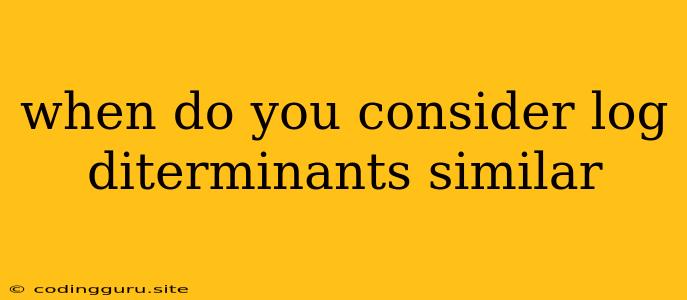When Do You Consider Log Determinants Similar?
The concept of "similarity" between log determinants is a multifaceted one, heavily dependent on the context and specific application. It's not a simple matter of comparing numerical values. Let's break down the different facets of this question and explore when you might consider log determinants "similar" in various scenarios.
Understanding Log Determinants
Before delving into similarity, it's essential to understand what log determinants represent. A determinant, often denoted as det(A), is a scalar value associated with a square matrix. The determinant encapsulates key properties of the matrix, particularly its invertibility. A non-zero determinant signifies an invertible matrix, while a zero determinant indicates a singular matrix.
The log determinant, denoted as log(det(A)), essentially "scales" the determinant. It's a logarithmic transformation that can be advantageous in certain contexts.
- Scaling: Logarithms are known for scaling large numbers down, making them easier to handle. This can be especially helpful when working with extremely large determinants.
- Mathematical Convenience: In some statistical and machine learning applications, log determinants appear naturally within formulas, making it convenient to work with them directly.
Different Interpretations of Similarity
Here's where things get interesting. "Similar" can mean different things depending on the context:
1. Numerical Similarity
The simplest interpretation is that log determinants are similar if their numerical values are close to each other. However, this can be misleading. Consider two log determinants:
- log(det(A)) = 10
- log(det(B)) = 11
While these values are "close" numerically, the original determinants are quite different:
- det(A) = e^10 ≈ 22026
- det(B) = e^11 ≈ 59874
Thus, a small difference in log determinant values can correspond to a significant difference in the actual determinants.
2. Relative Similarity
A more meaningful approach might be to consider the relative difference between the log determinants:
Relative Difference = |log(det(A)) - log(det(B))| / log(det(A))
If this relative difference is small (e.g., less than 1%), you could argue that the determinants are relatively similar.
3. Similarity in the Context of a Problem
The most nuanced interpretation of similarity depends heavily on the specific problem you're working on.
- Machine Learning: In certain machine learning algorithms, log determinants appear in regularization terms. Here, "similar" might mean that the two determinants are similar enough not to significantly alter the optimization process or final model performance.
- Statistical Analysis: In statistical analysis, log determinants can be associated with covariance matrices. "Similar" in this case might imply that the underlying distributions of the data represented by the two matrices are not vastly different.
Examples
Example 1: Gaussian Distributions
Let's say you have two Gaussian distributions with covariance matrices A and B. The log determinants of these matrices are related to the volume of the probability ellipsoids representing the distributions. If the log determinants are "similar," it suggests that the corresponding probability ellipsoids are not significantly different in size, indicating that the two distributions are similar in their spread.
Example 2: Image Analysis
In image analysis, log determinants can be used to measure the "smoothness" of an image. Images with similar log determinants might appear similar in terms of their overall texture and smoothness.
Conclusion
The answer to "when do you consider log determinants similar" depends on the context and the specific goals of your analysis. There's no one-size-fits-all answer. Think about the specific meaning of the log determinant in your problem, and how variations in its value might impact the results.
Remember: Numerical similarity doesn't always equate to meaningful similarity. Consider the relative difference, the context of your application, and the impact of variations in the log determinant on your overall analysis.
